COMMENTS ON THE ART MARKET
Gallery News
Current Exhibition

Rehs Contemporary, in partnership with Artefex, is pleased to present, Beneath the Surface, an exhibition featuring 17 premier contemporary artists. While most art exhibits are solely focused on the artwork aesthetics, Beneath the Surface highlights the fact that artworks are more than just a layer of paint. The exhibit runs through April 22nd.
____________________
Stocks & Crypto
By: Lance
The first quarter of 2022 is in the books, and it’s tough to make sense of what we’re seeing. Although the markets experienced steep declines on final day of March, the major indices rebounded nicely this month – and there’s not much positive news. Inflation accelerated, Putin’s invasion of Ukraine escalated, the Fed announced its first rate hike since 2018, mortgage rates jumped to nearly 5%, and we saw a good ol’ Treasury yield curve inversion – woo, good times keep coming! For those who do not know the significance of a yield curve inversion, it is a closely monitored signal of the economy’s long-term prospects… its occurrence has preceded every US recession in the past 50 years – typically within 2 years.
The short-term rationalization is that some of the worst fears about the economy did not materialize with respect to inflation – much of the rising costs were passed on to consumers, and in some cases that boosted profits. That may explain why the Dow was up 2.5%, NASDAQ was up 3.7%, and the S&P 500 was up 3.8% for the month. The Pound and Euro were fairly stable, both ending down about 1% from the start of the month. Gold closed out March up 2%, but saw a big pop the first week of the month as it topped $2,070… with all of the concerns floating around, it shouldn’t surprise anyone that this quarter was good for gold - it experienced the largest quarterly gain in two years. In similar fashion, crude oil jumped to levels we haven’t seen since the 2008 financial crisis… while it was brief, futures approached $130. News broke yesterday that Biden plans to release US oil reserves, causing oil to settle down to the $100 range.
As usual, crypto was volatile… Bitcoin dropped about 15% the first week of March into the $37K ballpark, before riding up to almost $50K by the end of the month – a 6% gain. Ethereum also saw a quick 15% drop but had a more significant recovery, finishing off March up more than 17%. Litecoin was right in the middle with an 11% gain.
Again, there is not much that indicates a positive outlook for the markets… but at least the weather is getting a bit warmer. Enjoy!
____________________
The Dark Side
By: Alyssa & Nathan
Anna Sorokin: Can Artist Turned Artist?
I hadn’t heard of Anna Sorokin until last month when I learned that Netflix had come out with a nine-episode miniseries based on her exploits. But reading about her life consistently and unfailingly left me baffled. For four years, she stole hundreds of thousands of dollars from people who thought they were her friends. And now she’s trying to sell her art from jail.
Anna Sorokin was born just outside Moscow in 1991, moving to Germany with her family at 16. She tried working at public relations companies and fashion magazines in the UK and France, with limited success. In 2013, Sorokin moved to New York, which became her main hunting ground. She enmeshed herself into New York’s elite social circles by passing herself off as a German heiress named Anna Delvey. She spent the next several years living in hotels, attending parties, and soliciting donations for an eventual arts space at the Church Missions House on Park Avenue. She racked up hotel bills worth thousands of dollars, went on expensive vacations, and conveniently forgot her wallet or claimed her cards weren’t working when it was time to pay. She even tried (and failed) to get a loan from two different banks for $22 million using fake documents she threw together on Microsoft Word. After one of her acquaintances realized what she was doing, the Manhattan District Attorney had Sorokin arrested on charges of first-, second-, and third-degree grand larceny, check fraud, and some misdemeanors. In the end, it is estimated she stole $275,000. After she was convicted in 2019, she was forced to pay fines and restitution on top of a prison term. She’s currently out on parole, having served only a fraction of her jail time, but is now in the process of being deported back to Germany.
One of the ways Sorokin has tried to remain active is by creating drawings commenting on her situation and having them posted on her social media pages. This has been enough for a merry band of supporters and sycophants to rush to her aid, protesting her deportation. The most dedicated of whom is Alfredo Martínez. Like attracts like, it seems. In the early 2000s, Martínez went to prison for creating and selling forged Basquiat paintings to two separate dealers. He started creating original work in prison, an example of which now hangs at New York’s Museum of Modern Art.
Sorokin’s “art” is more like second-rate cartoons you might find in some third-rate newspaper. And to be a confidence trickster, one must be extremely confident and equally narcissistic, which Sorokin’s drawings convey. They all deal with her and her situation and how bad she has it, like her detainment by US immigration services. Five of her drawings were featured at a show at a Lower East Side location for $10,000 each to help raise money. Plans for a solo show in April are already in the works. This is despite Netflix already paying her $320,000 for the rights to her life story to make the miniseries mentioned above. Clearly, this is not the last we’ve heard of Anna Sorokin, much to everyone’s chagrin.
____________________
Really?
By: Amy
New Record Price for Pokémon Illustrator Card
 Is inflation that bad, or has the world gone mad?? A new record auction price was achieved in the world of Pokémon this week when a 1998 Pokémon Illustrator card went under the hammer. In November of 2019, you may recall that I wrote about the rare Pokémon Pikachu Illustrator card when it sold for $195K, setting a record price. Since then, several other examples have sold. In 2020, a copy that was graded PSA9 was bought by an American collector for $233K through the Japanese site ZenPlus. Next, in 2021, one sold for $375K. Nowadays those prices seem like a bargain!
Is inflation that bad, or has the world gone mad?? A new record auction price was achieved in the world of Pokémon this week when a 1998 Pokémon Illustrator card went under the hammer. In November of 2019, you may recall that I wrote about the rare Pokémon Pikachu Illustrator card when it sold for $195K, setting a record price. Since then, several other examples have sold. In 2020, a copy that was graded PSA9 was bought by an American collector for $233K through the Japanese site ZenPlus. Next, in 2021, one sold for $375K. Nowadays those prices seem like a bargain!
Illustrator cards, released in 1998, were given to the winners of contests hosted by Shogakukan’s CoroCoro comics. Founded in 1977, CoroCoro is a monthly Japanese magazine for elementary-school boys. The contests asked readers to draw their favorite Pokémon characters. The winners were awarded the rare Pokémon Illustrator cards, with 39 cards given out over three contests.
The record-breaking card, graded PSA7 ‘near mint’ condition, sparked some aggressive bidding. Bidding started at just $75K, and with 34 bids, the card sold for $900K! While no one knows if and when the Pokémon bubble may burst, the next card that comes up for auction may well break the million-dollar mark!
Mickey Mantle Hits Another Home Run
Two recent sales demonstrate how baseball icon Mickey Mantle (1931- 1995) has remained an all-star. Mantle played for the New York Yankees his entire career and is considered one of the greatest players, especially the greatest switch hitter, in baseball history.
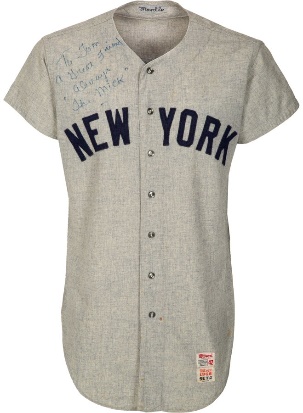 Mantle retired in 1968 after 16 seasons with the Yankees, and recently the last jersey he wore came up at auction- for the third time. The first time it crossed the auction block was in 2017 when it sold for $486K, then again in 2020, when it sold for $850K. Last week’s hammer price set a record for one of his jerseys.
Mantle retired in 1968 after 16 seasons with the Yankees, and recently the last jersey he wore came up at auction- for the third time. The first time it crossed the auction block was in 2017 when it sold for $486K, then again in 2020, when it sold for $850K. Last week’s hammer price set a record for one of his jerseys.
Worn by Mantle during his last games, the jersey is part of the legendary story of Mantle’s 535th home run. While playing the Detroit Tigers, Denny McLain, the Tigers’ pitcher, threw a ‘practice fastball’ to Mantle, enabling him to hit a homerun and supersede Jimmie Fox on the homerun list. If you are wondering why McLain was so generous, the Tigers had already secured the American League pennant. So it was no big deal for him to throw Mantle a ‘gift.’ In total, Mantle hit 536 career home runs, making him 18th on the list for most home runs in a career.
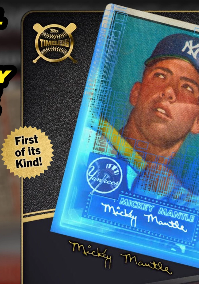 After Mantle retired, he gifted the jersey to Tom Catal, the president of the Mickey Mantle Museum, inscribing it, “To Tom, A Great Friend Always, The Mick.” With the impeccable provenance and estimated to bring more than $1M, the jersey certainly exceeded expectations when it hammered down for $1.825M ($2.19M w/p) – a new record for a Mantle jersey. Previously, the record was $1.32M set in 2018.
After Mantle retired, he gifted the jersey to Tom Catal, the president of the Mickey Mantle Museum, inscribing it, “To Tom, A Great Friend Always, The Mick.” With the impeccable provenance and estimated to bring more than $1M, the jersey certainly exceeded expectations when it hammered down for $1.825M ($2.19M w/p) – a new record for a Mantle jersey. Previously, the record was $1.32M set in 2018.
Also of note is that the proceeds from the sale will go to the Virgil Abloh "Post-Modern" Scholarship Fund, a charity established by Abloh in 2020 to provide scholarships within the fashion industry for the next generation of Black fashion industry leaders.
A Passion for Collecting Antique Toys

The excitement a new toy brings to a child’s face can be magical. International model and art gallery owner Monique Knowlton grew to love antique toys after seeing some incorporated into art installations, and collecting toys became a passion for her. Knowlton’s collection included a spectacular assortment of comic and cartoon characters, German toy cars, American toys, and Japanese robots and space toys.
Knowlton was highly particular in her purchases and stated, ‘Even if toys were very rare, I wouldn’t buy them if their condition wasn’t 100 percent. I wanted things that were perfect, original, and working, and if I had a choice, I would always buy a toy that had its original box.”
Recently her collection was auctioned, and there was some very animated bidding, particularly for everyone’s favorite mouse – and I don’t mean Stuart Dunkel’s Chuckie (though he is our favorite mouse). Of course, it’s Mickey Mouse! The top lot in the sale was a Mickey and Minnie Mouse Motorcycle c. 1932 made by the German toy manufacturer Tipp & Co. When Knowlton bought the piece in 2010, she paid $65K on a $23-28K estimate. This time around, the estimate was just a bit higher, $25-40K, and the toy faced some strong competition as it raced across the auction block. When the auctioneer’s hammer came down, the new owner drove away with a $185K ($222K w/p) magical motorcycle.
A Passion for Collecting Antique Toys
 Tom Brady has found a new way to deflate a football – this time, the controversy doesn’t have Brady allegedly ordering the physical deflation of footballs used in games, like in 2014 against the Indianapolis Colts. In this case, Brady has “deflated” the value of a football.
Tom Brady has found a new way to deflate a football – this time, the controversy doesn’t have Brady allegedly ordering the physical deflation of footballs used in games, like in 2014 against the Indianapolis Colts. In this case, Brady has “deflated” the value of a football.
Lelands Auctions recently offered the ‘last’ football Tom Brady threw in an NFL playoff game before announcing his retirement at the end of this past season. With just 3 minutes 20 seconds to go in the game against the LA Rams, Mike Evans caught Brady’s 55-yard pass and scored a touchdown closing the gap in the score to 27 -20. As Evan’s has done in the past, he threw the ball into the stands, and the lucky fan who caught it decided to consign it for auction. In the end, the Rams prevailed, and Brady announced his retirement a week later.
The winning bidder, seduced by the fact that this was the last football Brady threw for a touchdown, was willing to pay A LOT! Online bidding started at $100K, and after 28 bids, the football flew to a final price of $518K. Here’s the problem – just hours after the bidding closed, Brady decided to return for another season!
One would have to imagine the value of this football just dropped considerably, as with Brady’s return this will no longer be the last football he throws for a touchdown. There have been no reports of a formal comment from the buyer or auction house, but who knows if the buyer will actually pay for their purchase. The buyer has 30 days to pay, and rumor has it that the auction house may not force the sale since, technically, the cataloging of the football is no longer accurate. Another football Brady has allegedly deflated.
____________________
The Art Market
By: Howard & Nathan
Christie’s Evening Sales – 20th/21st Century & The Art of the Surreal
By: Howard
 On March 1st, Christie’s offered a set of three auctions between Shanghai and London, which lasted some 5 hours. (Prices shown are with the buyer’s premium)
On March 1st, Christie’s offered a set of three auctions between Shanghai and London, which lasted some 5 hours. (Prices shown are with the buyer’s premium)
he first auction took place in Shanghai and featured 20 lots, with the top seller being Basquiat’s 1982 painting, Il Duce (The Leader), which brought CNY94.1M/$15.06M on a CNY80-120M ($12.8-19.2M) estimate. In 2017, Christie’s offered this work with a $25-35M estimate, and the saleroom guaranteed it; it failed to sell, so they likely took a bit of a loss. Taking the second spot was Zao Wou-Ki’s Le soir à l’Hôtel du Palais (Palace Hotel by night) from 2004. The piece was acquired directly from the artist, carried a CNY11-18M estimate ($1.8-2.9M), and sold for CNY24.4M/$3.9M. Rounding out the top three was Kees van Dongen’s La femme au collier. The painting was purchased in 2008 from a London gallery, had a CNY19.5-32M estimate ($3.1-5.1M), and brought CNY23.2M/$3.7M.
Several works performed very well; these included Boafo’s Orange Shirt – CNY8.76M/$1.4M (est. CNY3-5M – this same painting sold about two years ago for $212.5K), Figgis’ Debutants Ball – CNY4.03M/$545K (est. CNY800-1.2M), and Ewa Juszkiewicz’s Untitled – CNY3.3M/$524K (est. CNY220-500K).
Of the 20 lots offered, 19 sold (a sell-through rate of 95%), and the total reached CNY222M/$35.5M. The low end of their estimate range was CNY141.5M, so they made it with plenty of room to spare.
Next up was the London auction, consisting of 68 lots, 4 of which were withdrawn before the sale started. (Both hammer and buyer’s premium – w/p – prices are shown)
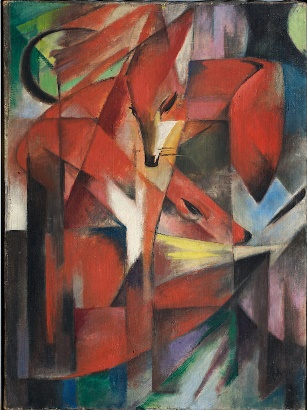 The star of this segment was Franz Marc’s The Foxes – a recently restituted works from the Städtische Kunstsammlung, Dusseldorf, to the heirs of Kurt and Else Grawi. The painting was expected to bring £35M and hammered at £37M/$46.7M (£42.4M/$56.6M w/p) — I am sure the heirs are now very happy and quite a bit richer! Next came Francis Bacon’s Triptych 1986-7. This large, late work (completed about five years before his death) carried a £35-55M estimate and brought £35M/$47M (£38.5M/$51.3M w/p). I can only assume that the seller – Norman Foster – was satisfied with the result. The third spot saw Lucian Freud’s Girl with Closed Eyes fall in the middle of its £10-15M estimate when it sold for £13M (£15.2/$20.2M w/p). Rounding out the top five were Marc Chagall’s Le jongleur at £7.5M/$10M (£8.9M/$12M w/p) – the work last sold in 2005 for $4M, another happy seller – and Fernand Leger’s Composition (from 1920) which made £5.2M/$6.9M (£6.24M/$8.4M w/p).
The star of this segment was Franz Marc’s The Foxes – a recently restituted works from the Städtische Kunstsammlung, Dusseldorf, to the heirs of Kurt and Else Grawi. The painting was expected to bring £35M and hammered at £37M/$46.7M (£42.4M/$56.6M w/p) — I am sure the heirs are now very happy and quite a bit richer! Next came Francis Bacon’s Triptych 1986-7. This large, late work (completed about five years before his death) carried a £35-55M estimate and brought £35M/$47M (£38.5M/$51.3M w/p). I can only assume that the seller – Norman Foster – was satisfied with the result. The third spot saw Lucian Freud’s Girl with Closed Eyes fall in the middle of its £10-15M estimate when it sold for £13M (£15.2/$20.2M w/p). Rounding out the top five were Marc Chagall’s Le jongleur at £7.5M/$10M (£8.9M/$12M w/p) – the work last sold in 2005 for $4M, another happy seller – and Fernand Leger’s Composition (from 1920) which made £5.2M/$6.9M (£6.24M/$8.4M w/p).
Of the 64 works that were offered, 54 sold (84.4% sell-through rate), and by my calculations, the total take was £153M/$205M (£182.7M/$244.5M w/p). The low end of their estimate range was about £152M, so they just squeezed by. Looking a little deeper, we find that 8 works sold below, 27 with, and 19 above their estimate ranges. This gave them an accuracy rate of 42%, which is a pretty high number. But the evening was not over; next up the Surrealists
Shortly after the big auction, a selection of 21 Surrealist works was offered – hey, the fun never ends! (Prices shown are with the buyer’s premium)
 Taking the number one spot was an artist whose works seem to cover most of the leading art movements of the 20th century – Pablo Picasso. His 1929 painting La fenêtre ouverte, which had been in a family collection since 1974, was expected to sell in the £14-24M range and realized £14M/$18.7M (£16.32M/$21.8M w/p), just hitting the low end of its estimate. Then came René Magritte’s La lumière du pole that was estimated to bring £5.5-7.5M and ended up selling for £5.99M/$8M w/p. In third they saw Joan Miró’s Personnage, oiseau, étoile dans un paysage (from 1978) bring in £3.04M/$4.07M w/p on a £1.5-2.5M estimate. The seller acquired the painting back in 1996 for about $600K — so there was another happy seller.
Taking the number one spot was an artist whose works seem to cover most of the leading art movements of the 20th century – Pablo Picasso. His 1929 painting La fenêtre ouverte, which had been in a family collection since 1974, was expected to sell in the £14-24M range and realized £14M/$18.7M (£16.32M/$21.8M w/p), just hitting the low end of its estimate. Then came René Magritte’s La lumière du pole that was estimated to bring £5.5-7.5M and ended up selling for £5.99M/$8M w/p. In third they saw Joan Miró’s Personnage, oiseau, étoile dans un paysage (from 1978) bring in £3.04M/$4.07M w/p on a £1.5-2.5M estimate. The seller acquired the painting back in 1996 for about $600K — so there was another happy seller.
There were 21 works offered, and all were sold (100% sell-through rate). The total take was £39.9M/$53.4M w/p on a presale estimate range was £30.5-47.7M, so they made it even without the buyer’s premium. That was nice to see.
By the end of the three sessions, the total for the evening was £249M/$334M w/p on a presale estimate of £208-299M ($278-398M). They offered 105 works and sold 94, giving them a sell-through rate of 89.5%. Again, not too bad.
Par for the Course: Sotheby’s Modern & Contemporary Evening Sale
By: Nathan
Wednesday’s Modern & Contemporary evening sale at Sotheby’s London showroom saw fifty-four works from some of the most recognizable names in the visual arts come up to the auction block. But while an auction like this typically has the wealthy clamoring to get their hands on a painting or a bronze, this sale went… just okay. There were no wow moments, as almost everything stayed within their estimates, and there were no fast-paced bidding wars or unexpected hammer prices.
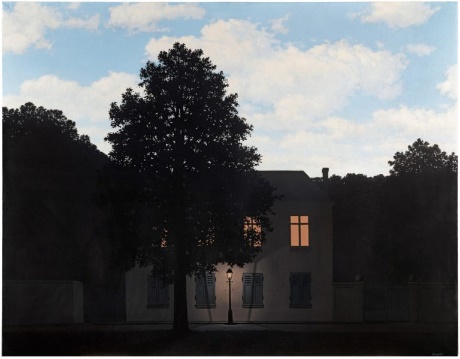 The sale’s headliner was René Magritte’s surrealist painting L’empire des lumières: a house among trees shrouded in the darkness of night, all underneath a bright, blue, midday sky. After stalling at £45 million, the auctioneer lingered long enough to get the hammer price up to £51.5 million (or £59.4 million w/p). While it fell short of its £60 million estimate, the auctioneer wasted no time in reminding the room that this was a new auction record for a work by Magritte. The previous record-holder, entitled Le principe du plaisir, sold at Sotheby’s New York in 2018 for $23.5 million (or $26.8 million w/p). But anyone paying attention to Wednesday’s sale should not have been surprised since the painting was guaranteed and the bidding started at £40 million. It takes the excitement out of an event when the outcome is ensured. In their description, the Sotheby’s specialists made sure to refer to L’empire des lumières as “[o]ne of the Belgian master’s finest works”. And while the subject is undoubtedly intriguing, some may not see the work as such. It’s simply not as striking as many of Magritte’s other great surrealist works, like Le fils de l’homme or La Durée poignardée. During the Art of the Surreal evening sale at Christie’s, five Magritte works were sold, including one previously owned by Sophia Loren. All of them were far more remarkable than the dark canvas sold for a record price at Sotheby’s. This was especially the case with La mémoire, a 1942 gouache painting: a jingle bell, a rose, and the bloodstained head of a female statue on a wooden surface against a darkening seascape. While it sold for £1.7 million (or £2.08 million w/p), far less than L’empire des lumières, at least it reached its estimate.
The sale’s headliner was René Magritte’s surrealist painting L’empire des lumières: a house among trees shrouded in the darkness of night, all underneath a bright, blue, midday sky. After stalling at £45 million, the auctioneer lingered long enough to get the hammer price up to £51.5 million (or £59.4 million w/p). While it fell short of its £60 million estimate, the auctioneer wasted no time in reminding the room that this was a new auction record for a work by Magritte. The previous record-holder, entitled Le principe du plaisir, sold at Sotheby’s New York in 2018 for $23.5 million (or $26.8 million w/p). But anyone paying attention to Wednesday’s sale should not have been surprised since the painting was guaranteed and the bidding started at £40 million. It takes the excitement out of an event when the outcome is ensured. In their description, the Sotheby’s specialists made sure to refer to L’empire des lumières as “[o]ne of the Belgian master’s finest works”. And while the subject is undoubtedly intriguing, some may not see the work as such. It’s simply not as striking as many of Magritte’s other great surrealist works, like Le fils de l’homme or La Durée poignardée. During the Art of the Surreal evening sale at Christie’s, five Magritte works were sold, including one previously owned by Sophia Loren. All of them were far more remarkable than the dark canvas sold for a record price at Sotheby’s. This was especially the case with La mémoire, a 1942 gouache painting: a jingle bell, a rose, and the bloodstained head of a female statue on a wooden surface against a darkening seascape. While it sold for £1.7 million (or £2.08 million w/p), far less than L’empire des lumières, at least it reached its estimate.
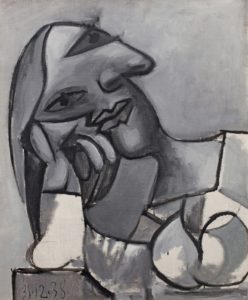 The rest of the auction had very few surprises, if at all. They stayed within their estimates, some of them a little high to begin with. Nymphéas, one of Claude Monet’s waterlily paintings, hit its £20 million high estimate, a rather high price tag given the work is stamped with Monet’s signature rather than properly signed. David Hockney took third when his 2017 acrylic on canvas Garrowby Hill brought in £12.05 million (or £14.09 million w/p). The landscape, with its irregularly hexagonal canvas and its bright colors typical of Hockney’s work, was one of the magnificent, unsung heroes of the sale. It contrasted perfectly with the dull, drab Picasso painting Buste de femme accoudée, gris et blanc that sold for £10.5 million (or £11.9 million w/p). It’s inconceivable that someone would shell out that much money, not only because the work is so dreary, but also because the work is completely unsigned.
The rest of the auction had very few surprises, if at all. They stayed within their estimates, some of them a little high to begin with. Nymphéas, one of Claude Monet’s waterlily paintings, hit its £20 million high estimate, a rather high price tag given the work is stamped with Monet’s signature rather than properly signed. David Hockney took third when his 2017 acrylic on canvas Garrowby Hill brought in £12.05 million (or £14.09 million w/p). The landscape, with its irregularly hexagonal canvas and its bright colors typical of Hockney’s work, was one of the magnificent, unsung heroes of the sale. It contrasted perfectly with the dull, drab Picasso painting Buste de femme accoudée, gris et blanc that sold for £10.5 million (or £11.9 million w/p). It’s inconceivable that someone would shell out that much money, not only because the work is so dreary, but also because the work is completely unsigned.
While Sotheby’s heavily promoted the Magritte as a future record-setter, the auction wasn’t much of a success on the whole. While the entire sale was predicted to bring in anywhere between £169.8 million to £216 million, the total amount spent on Wednesday fell a bit short of the low end at £162,740,000. Not an insignificant amount of money, but a little disappointing given what Sotheby’s predicted.
British and European Painting Sale Hits the Mark
By: Howard
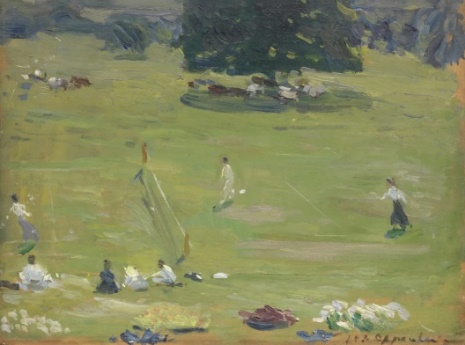 On March 9th, Bonhams, London, presented their British and European Painting sale — a selection of more affordable 19th and 20th-century paintings – you know, works carrying estimates like £800-1.2K, £2-3K, and £10-15K. It was a bit of a mixed bag with oils, watercolors, and drawings. (Unless otherwise noted, all prices are hammer price –w/p – with the buyer’s premium)
On March 9th, Bonhams, London, presented their British and European Painting sale — a selection of more affordable 19th and 20th-century paintings – you know, works carrying estimates like £800-1.2K, £2-3K, and £10-15K. It was a bit of a mixed bag with oils, watercolors, and drawings. (Unless otherwise noted, all prices are hammer price –w/p – with the buyer’s premium)
The top lot of the session was Josef Oppenheimer’s The Tennis Match. This small (9 5/8 x 13 ¼ inch) impressionist work was expected to sell in the £5-7K range and hammered for £32K/$42K (£40.3K/$53K w/p). So, we can all agree that it performed well. Next came Ernest Croft’s Funeral of Her late Majesty Queen Victoria. When I first saw the image, I wondered if anyone would be interested in purchasing a painting of a funeral procession? Obviously, someone was willing to spend £17K/$22K (£21.5/$28K w/p – est. £12-18K). It shows you what I know! In the number three spot, we find Charles Burton Barber’s The Lamb with the Lion at £14K/$18.4K (£17.8/$23.3K w/p – est. £10-15k). Rounding out the top five there was a tie: F.M. Bennett’s A Hearty Lunch (est. £6-8K) and Ernest Pierre Guérin’s Jour de fête à Notre Dame de la Joie (est. £5-7K) both hammered at £12K/$15.7K (£15.3/$20K w/p).
Several lots also performed well in the British and European Painting sale; these included works by Marianne Stokes (£8K – est. £2-3K), Edgar Maxence (£7K – est. £2-3K), Jerzy Kossak (£5.5K – est. £1-1.5K), Clare Atwood (£4K – est. £1.5-2K), Dame Laura Knight (£3.5K – est. £1-1.5K), and Walter Williams (£2.5 – est. £800-1.2K). Then some did not do well or were withdrawn (usually because there was no presale interest). Among them were works by Munnings (£1.5-2K – withdrawn), Raphael Lewisohn (£4-6K – unsold), Pierre Outin (£3-5K – withdrawn), Vincenzo Irolli (£8-12K – unsold), and Antonio Mancini (£20-30K – withdrawn).
I will say that the sale moved along pretty quickly, and by the time it finished, of the 207 lots in the ‘catalog’, seven were withdrawn. Of the remaining 200, 155 were sold (77.5% sell-through rate – which is pretty good), and the total take was £460K. The presale estimate range was £450-660K, so they just hit it. Looking a bit closer, we find that 32 sold below, 67 within, and 56 above their estimates; this left them with an accuracy rate of 33.5% — which is very respectable.
While this British and European Painting sale did not feature any expensive 19th-century works of art, it is an excellent example of what can happen when the estimates align with the works’ quality, condition, and level of importance. In the 19th century arena, anything above a 75% sell-through rate is considered very good.
Christie’s Modern British and Irish Evening Sale
By: Nathan
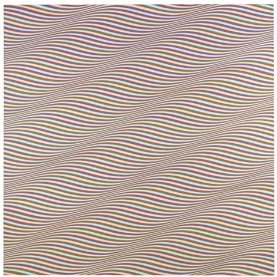 This Tuesday, Christie’s London hosted a short, hour-long auction for their Modern British and Irish evening sale. It was a very strong day for Christie’s, with nearly all the lots either hitting or exceeding their estimates. Of the thirty-one lots offered, only six sold below estimate, were bought in, or were withdrawn. (w/p = with the buyer’s premium) The highlights include Bridget Riley’s 1974 acrylic-on-canvas painting entitled Gala, which reached the top spot with a £3.6M/$4.75M hammer price (or £4.36M/$5.76M w/p). Throughout the sale, the five-foot by five-foot painting was prominently placed in the auction room, right behind the phone desk. It’s a giant, dazzling optical illusion. The pattern makes it seem like a rippling sheet constantly moving, making one dizzy at times. The bidding dragged on for maybe a little too long, as an indecisive phone bidder kept everyone waiting for two or three extra minutes before accepting defeat and letting it go to another. The auctioneer closed the next lot in about thirty seconds, probably to compensate for the delay.
This Tuesday, Christie’s London hosted a short, hour-long auction for their Modern British and Irish evening sale. It was a very strong day for Christie’s, with nearly all the lots either hitting or exceeding their estimates. Of the thirty-one lots offered, only six sold below estimate, were bought in, or were withdrawn. (w/p = with the buyer’s premium) The highlights include Bridget Riley’s 1974 acrylic-on-canvas painting entitled Gala, which reached the top spot with a £3.6M/$4.75M hammer price (or £4.36M/$5.76M w/p). Throughout the sale, the five-foot by five-foot painting was prominently placed in the auction room, right behind the phone desk. It’s a giant, dazzling optical illusion. The pattern makes it seem like a rippling sheet constantly moving, making one dizzy at times. The bidding dragged on for maybe a little too long, as an indecisive phone bidder kept everyone waiting for two or three extra minutes before accepting defeat and letting it go to another. The auctioneer closed the next lot in about thirty seconds, probably to compensate for the delay.
The other top spots belonged to Sir John Lavery’s Croquet Party, which went for £2.4M/$3.17M (or £2.9M/$3.86M w/p), as well as The Sea by Laurence Stephen Lowry, which fetched £2.25M/$2.97M million (or £2.74M/$3.6M). While the Lowry is certainly striking, I was more excited to see the artist’s painting The Village Street. While it’s a smaller work, it’s much more dynamic and colorful, deserving of the £1.6M/$2.1M it reached (or £1.96M/$2.6M w/p), especially compared to The Sea’s relatively dull, monochrome waves. One of the only surprises happened right before The Sea came across the block. Despite it being on the smaller side, Sir William Nicholson’s oil-on-canvas work Miss Simpson’s Boots seemed to catch several buyers’ attention. It quickly shot past its £500K high estimate assigned by Christie’s specialists, reaching £1.45M/$1.9M (or £1,.78M/$2.35M w/p) within a few minutes.
The thirty lots offered (one was withdrawn) brought in £20.7M/$27.3M, which fell within Christie’s total estimate between £14.95 million to £21.74 million.
Sotheby’s Schmit Collection, Part II
By: Nathan
 This Thursday, Sotheby’s Paris saw the second half of Robert and Nadine Schmit’s collection come across the block. (w/p = with buyer’s premium) The first half was already featured at a sale back in early December. Robert Schmit was a prominent art collector who operated his own gallery on the rue Saint-Honoré in Paris. Starting in the 1960s, he and his wife Nadine became known as some of the top collectors of nineteenth-century French paintings, especially works by Eugène Boudin and Gustave Courbet. So it wasn’t very surprising when Courbet’s La Pauvresse de village took the top spot at the sale. A peasant woman hauls a bundle of kindling on her back, trudging through the snow accompanied by her young daughter and a goat that she’s pulling on a rope. Though a later work from 1866, the painting is more typical of Courbet’s earlier social realist works like The Stone Breakers or The Wheat Sifters. It exceeded its original million-euro estimate, selling for €1.4M/$1.54M (or €1.73M/$1.9M w/p).
This Thursday, Sotheby’s Paris saw the second half of Robert and Nadine Schmit’s collection come across the block. (w/p = with buyer’s premium) The first half was already featured at a sale back in early December. Robert Schmit was a prominent art collector who operated his own gallery on the rue Saint-Honoré in Paris. Starting in the 1960s, he and his wife Nadine became known as some of the top collectors of nineteenth-century French paintings, especially works by Eugène Boudin and Gustave Courbet. So it wasn’t very surprising when Courbet’s La Pauvresse de village took the top spot at the sale. A peasant woman hauls a bundle of kindling on her back, trudging through the snow accompanied by her young daughter and a goat that she’s pulling on a rope. Though a later work from 1866, the painting is more typical of Courbet’s earlier social realist works like The Stone Breakers or The Wheat Sifters. It exceeded its original million-euro estimate, selling for €1.4M/$1.54M (or €1.73M/$1.9M w/p).
The other top lots featured were Tournant du Loing by Alfred Sisley, a landscape showing a tributary of the Seine which sold for €400K/$440K (or €504K/$554K w/p). There was also a landscape of Brest harbor by Eugène Boudin with disembarking sailors in the foreground, which went for €290K/$319K (or €365.4K/$401.9K w/p). There were also one or two surprises along the way. A portrait by Eugène Delacroix hit €90K/$99K (or €113.4K/$124.7K w/p), tripling its original estimate after someone put in a €70K advance bid. A little later on, a double-sided watercolor and gouache work by Johan Barthold Jongkind shattered its original estimate by selling for €9K, which was six times what Sotheby’s specialists said it would go for. One side shows a verdant landscape, indicated by the artist to be in Balbins, halfway between Lyon and Grenoble. The other side seems to be studies of farmers with carts full of hay, which Jongkind wrote were the residents of the town of Côte-Saint-André, right next to Balbins.
Fifty-four of the seventy-eight lots offered, over two-thirds, hit or beat their estimates. Sotheby’s specialists correctly estimated the total sale to bring in anywhere between €2.7M and €4M. Despite thirteen lots being bought in, the sale made €3.93M/$4.3M (€4.92M/$5.4M w/p), just shy of exceeding the total maximum estimate.
Sotheby’s Orientalist Sale
By: Nathan
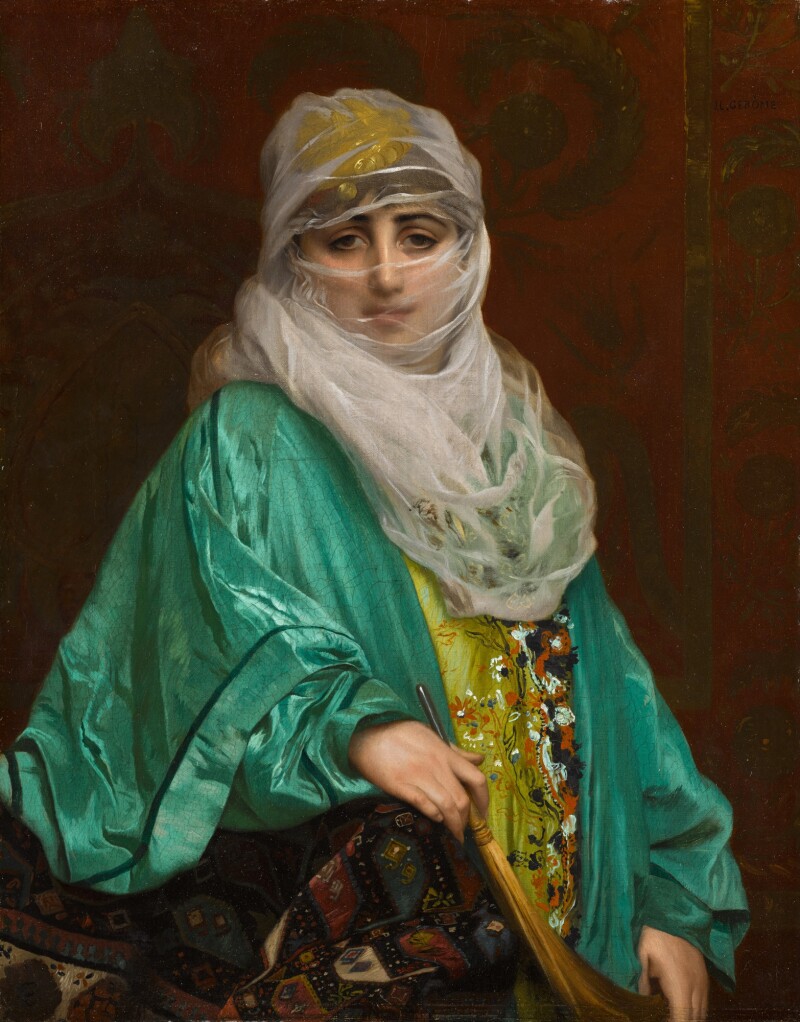 This past Tuesday, Sotheby’s held their Orientalist sale, featuring sixty-six works by various European and North American artists, predominantly French. While the sale as a whole didn’t do as well as Sotheby’s specialists estimated, there were still some beautiful works up for grabs, some of which went for some unexpected prices. Sotheby’s experts put their faith in Jean-Léon Gérôme’s Veiled Beauty. This one painting makes it clear that some late nineteenth-century French people were rather uninformed about the various cultures represented in the art they bought. Throughout the painting’s life in catalogues and exhibitions, it was called The Mysterious Algerian Woman and Woman of Constantinople. Well, which one is it? Those are two very different places separated by 1400 miles. But it doesn’t matter since one of the points of Orientalism was to portray an exotic other, often disregarding the actual people and cultures to make something beautiful for European canvases (w/p = with buyer’s premium).
This past Tuesday, Sotheby’s held their Orientalist sale, featuring sixty-six works by various European and North American artists, predominantly French. While the sale as a whole didn’t do as well as Sotheby’s specialists estimated, there were still some beautiful works up for grabs, some of which went for some unexpected prices. Sotheby’s experts put their faith in Jean-Léon Gérôme’s Veiled Beauty. This one painting makes it clear that some late nineteenth-century French people were rather uninformed about the various cultures represented in the art they bought. Throughout the painting’s life in catalogues and exhibitions, it was called The Mysterious Algerian Woman and Woman of Constantinople. Well, which one is it? Those are two very different places separated by 1400 miles. But it doesn’t matter since one of the points of Orientalism was to portray an exotic other, often disregarding the actual people and cultures to make something beautiful for European canvases (w/p = with buyer’s premium).
Sadly, A Veiled Beauty fell just short of its £250K minimum estimate, going for £220K / $287.8K (or £277.2K / $362.7K). Gérôme’s work instead enjoyed second place right behind the unexpected star of the auction: David Roberts’s The Bazaar of the Coppersmiths, Cairo. The bazaar painting was part of a series of Cairo street scenes created by Roberts during the 1840s, with one currently in the British royal family’s collection. The Bazaar of the Coppersmiths was originally expected to go for £80K maximum. So it came as a great surprise when it soared past its estimate and reached £320K / $418.7K (or £403.2K / $527.5K), exactly four times what Sotheby’s experts predicted. Third place went to Sunset on the Nile by Charles Théodore Frère, exceeding its £80K high estimate, though not as exponentially as the Roberts work. The six-foot-wide oil painting, which sold for £105K / $137.4K (or £132.3K / $173.1K), is a gorgeous study in orange and black. The women collecting water on the riverbank, the herd of camels and cattle off in the distance, and the felucca boat gracefully floating by are all silhouettes when put against the warm glow of the Egyptian sun, which has just disappeared below the horizon.
While Bazaar of the Coppersmiths was the biggest surprise of the sale, it wasn’t the only one. Georges Washington’s Mounted Warrior also surpassed expectations, selling for £60K / $78.6K (or £75.6 / $99K) when experts predicted it would only go for £18K. Similarly, a portrait by the Austrian Rudolf Ernst entitled A Bashi-Bazouk shows a mustachioed and turbaned Ottoman soldier. It shot past its £15K estimate and sold for £42K / $55K (or £52.9K / $69.3K).
Forty-three of the sixty-six lots offered, or about 65%, met or exceeded their estimates. Meanwhile, fifteen of the lots, about 22.7%, were unsold. Sotheby’s specialists expected everything to go for anywhere between £1.95 million to £2.83 million. Unfortunately, the sale fell short, reaching £1.83 million (or $2.4M). This was likely because many of the lots passed over by buyers were some of the highly-valued works featured. These included William Simpson’s Jerusalem from the Mount of Olives (est. £80K to £120K), Ludwig Deutsch’s Before the Mosque (est. £200K to £300K), and even the painting chosen as the thumbnail and banner image for the whole sale on Sotheby’s website: Jean Discart’s The Basket Weaver, Tangier (est. £120K to £180K).
____________________
Deeper Thoughts
By: Nathan
Ukraine's Latest Loss
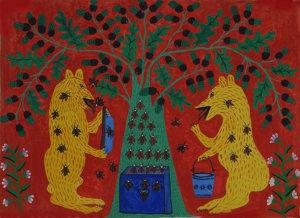 A video circulating on social media shows a museum on fire due to the current conflict in Ukraine. According to locals, within the first days of the invasion, Russian troops set fire to the Ivankiv Museum, about 50 miles north of Kyiv.
A video circulating on social media shows a museum on fire due to the current conflict in Ukraine. According to locals, within the first days of the invasion, Russian troops set fire to the Ivankiv Museum, about 50 miles north of Kyiv.
One of the first to condemn the museum’s destruction was James Cuno, president of the J. Paul Getty Museum in Los Angeles. Cuno wrote on February 28th, “News reports indicate that among the many atrocities being committed in Ukraine over the past few days of Putin’s War, Russian forces have begun destroying Ukrainian cultural heritage”. He also reiterated the art world's general view that protecting cultural heritage “is a core value of civilized societies."
Of all the works kept at the Ivankiv Museum, probably the most significant loss is around twenty-five works by one of Ukraine’s most renowned folk artists, Maria Prymachenko. During her lifetime, she was a well-known and respected artist, receiving honors from both the USSR and independent Ukraine. Two years after her death in 1997, the Ukrainian government featured her work on postage stamps, while her face was put on the 5 hryvnia coin in 2008. She received one of her greatest endorsements from Pablo Picasso, who called her an “artistic miracle”.
Millions of artworks and monuments are still at risk of being damaged or destroyed due to the fighting between invading Russian forces and Ukrainian defenders. Russian attempts to take Kyiv still pose a danger to the treasures kept at the city’s museums, as well as two of Ukraine’s seven UNESCO heritage sites. There are fears that the capital’s museums may be plundered and looted by Russian troops, with their contents transferred to institutions in Russia. Ukraine’s culture minister has now called on UNESCO to revoke Russia’s membership. Ukraine’s defenders have been successful so far at slowing the Russian advance, which may buy time for those seeking to safeguard the contents of the country’s museums. But who knows what may happen between now and when peace is restored?
Getting a Literal Bird’s-Eye View
 If a badger can get credit as an archaeologist, a cockatoo can undoubtedly be a judge in an art contest, right? Well, one art competition in Australia certainly thinks so. The Archibald Prize is awarded by the Art Museum of New South Wales for the best in Australian portraiture and is considered one of Australia’s most prestigious art prizes. Some of the country’s greatest artists, like Brett Whiteley and John Longstaff, have won the Archibald. Last year, it celebrated its hundredth anniversary with Peter Wegner’s Portrait of Guy Warren at 100 receiving the accolade. Of course, the perceived elitism and stuffiness of the arts establishment receives its fair share of criticism and mockery, and the Archibald Prize is no exception. That’s why every year since 1994, a parody competition called the Bald Archy prize is held for Australia’s most vulgar and humorous artworks. While art contests are normally judged by a panel of human experts, the Bald Archy’s primary judge is a cockatoo named Maude.
If a badger can get credit as an archaeologist, a cockatoo can undoubtedly be a judge in an art contest, right? Well, one art competition in Australia certainly thinks so. The Archibald Prize is awarded by the Art Museum of New South Wales for the best in Australian portraiture and is considered one of Australia’s most prestigious art prizes. Some of the country’s greatest artists, like Brett Whiteley and John Longstaff, have won the Archibald. Last year, it celebrated its hundredth anniversary with Peter Wegner’s Portrait of Guy Warren at 100 receiving the accolade. Of course, the perceived elitism and stuffiness of the arts establishment receives its fair share of criticism and mockery, and the Archibald Prize is no exception. That’s why every year since 1994, a parody competition called the Bald Archy prize is held for Australia’s most vulgar and humorous artworks. While art contests are normally judged by a panel of human experts, the Bald Archy’s primary judge is a cockatoo named Maude.
Theater director Peter Batey started the Bald Archy prize to poke fun at Australia’s arts establishment, and has since become Australia’s top event for satire in the arts. Since 2005, the Museum of the Riverina has hosted the contest in the small city of Wagga Wagga in New South Wales. While Batey died in a car accident in 2019, his pet cockatoo, Maude, has always been the only judge. According to the prize website, Maude is “the world’s premier avian art critic”. The entries are typically caricature portraits, mainly of Australian celebrities like Geoffrey Rush, Rupert Murdoch, and Julian Assange. After a pandemic hiatus, the Bald Archy award will return in 2023. And I’m sure Maude will make an excellent choice, as she always has. Honestly, I’m sure her selection would be just as valid as that handed down by the panel of expert judges that awards the Archibald Prize. We'll see.
Florentine Reunion: The New Donatello Exhibition
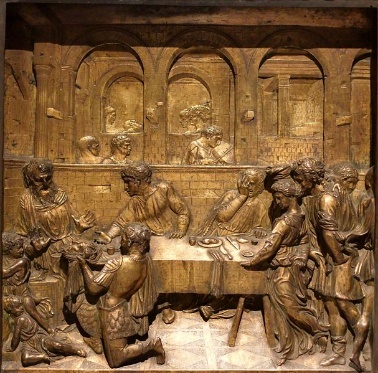 Two of Florence’s major cultural institutions will be joining forces to put on an exhibition dedicated to one of the city’s greatest artistic icons. Between March 19th and July 30th, the Palazzo Strozzi and the Museo Bargello will assemble around one hundred thirty works to show the story and the lasting legacy of the master sculptor Donatello. According to curators, it will be the first major retrospective on Donatello in more than forty years.
Two of Florence’s major cultural institutions will be joining forces to put on an exhibition dedicated to one of the city’s greatest artistic icons. Between March 19th and July 30th, the Palazzo Strozzi and the Museo Bargello will assemble around one hundred thirty works to show the story and the lasting legacy of the master sculptor Donatello. According to curators, it will be the first major retrospective on Donatello in more than forty years.
Donatello is often considered the first great master of the Renaissance. He was part of a generation of Florentine sculptors, like Filippo Brunelleschi and Lorenzo Ghiberti, who diligently studied classical sculpture to create their works. While Donatello was only one of many, people remember his name for a good reason. His innovations allowed him to create David, the first free-standing nude sculpture since antiquity. With his statue of Gattamelata, he also revived the concept of the commemorative equestrian statue, not popularly executed in Europe in over a millennium. Though Florentine by birth, his work can be found all over Italy, from Florence to Rome to Padua to Siena to Venice.
The exhibition will also feature works by his contemporaries, like Filippo Brunelleschi, as well as his successors, like Michelangelo, Raphael, and Giovanni Bellini. About fifty other art institutions, like the Louvre, the Metropolitan Museum of Art, and Vienna’s Kunsthistorisches Museum, are loaning some of their works for the exhibition. However, thanks to the Strozzi-Bargello partnership, museum visitors will learn about some of Donatello’s bronze works that have not left their original installations. The font at Siena Cathedral’s baptistry features several works by Donatello, including two small bronze statues and a bronze panel showing the Feast of Herod. These works have never been removed from the baptistry since they were installed in the 1420s, but will be carefully taken out of their churches for display in Florence. The exhibition will also feature a set of bronze doors that Donatello made for the sacristy of the Basilica of San Lorenzo in Florence. All the bronze works are currently undergoing cleaning and restoration in Florence before the exhibition begins.
The exhibition’s curator, Francesco Caglioti, hopes that the Museo Bargello will also agree to loan Donatello’s David to the event, which would undoubtedly eclipse all the other assembled works. Except for the sacristy doors and the Siena baptistry bronzes, the exhibit’s contents will travel to the Staatliche Museum in Berlin in September before continuing to London’s Victoria & Albert Museum.
Discovering More at Notre Dame
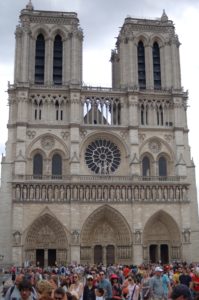 In December, I wrote about the state of Notre Dame Cathedral’s restoration following its devastating 2019 fire. And now, this week, workers have made a fascinating discovery at the site. While workers were testing the ground’s stability to prepare to rebuild the cathedral’s spire, they unearthed a medieval coffin from under the floor near the crossing, where the nave meets the transept. The French culture ministry claims that the coffin likely dates to the fourteenth century. Based on its location and the fact that it was made from lead, it most likely contains a prominent dignitary’s remains.
In December, I wrote about the state of Notre Dame Cathedral’s restoration following its devastating 2019 fire. And now, this week, workers have made a fascinating discovery at the site. While workers were testing the ground’s stability to prepare to rebuild the cathedral’s spire, they unearthed a medieval coffin from under the floor near the crossing, where the nave meets the transept. The French culture ministry claims that the coffin likely dates to the fourteenth century. Based on its location and the fact that it was made from lead, it most likely contains a prominent dignitary’s remains.
Like many medieval lead coffins, it was molded into the body’s shape. This was done for preservation since lead ensures that moisture is kept out, keeping the body intact. The British royal family continues this practice with their 500-pound lead-lined coffins, seen most recently during Prince Philip’s funeral. While the coffin is slightly warped from the weight of the stones and earth above, archaeologists have been able to peek inside using an endoscopic camera. Head archaeologist Christophe Besnier said they could see “pieces of fabric, hair and a pillow of leaves on top of the head, a well-known phenomenon when religious leaders were buried.” Some other artifacts were also uncovered, including pieces of statuary and parts of the original cathedral rood screen, removed around 1700 on the orders of Louis XIV.
Because of the find, the restoration efforts on the spire were halted until March 25th.
The Doodle Exhibition
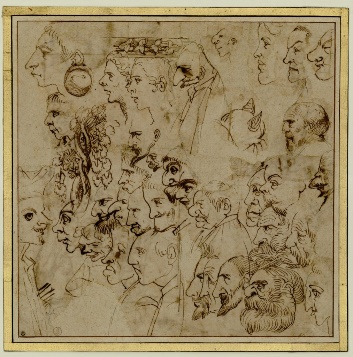 We all doodled and scribbled during school. Animals or 3D cubes or, if you’re a nineties kid like me, the Superman S covered the inside covers of notebooks and in the margins of notepaper. A new exhibition at a museum in Rome is now open to highlight and elevate the art of the doodle by showing that everyone does it, especially some of history’s greatest artists.
We all doodled and scribbled during school. Animals or 3D cubes or, if you’re a nineties kid like me, the Superman S covered the inside covers of notebooks and in the margins of notepaper. A new exhibition at a museum in Rome is now open to highlight and elevate the art of the doodle by showing that everyone does it, especially some of history’s greatest artists.
Scribbling & Doodling at the Academie de France, located at the Villa Medici in Rome, is the assembly of one hundred fifty works spanning centuries to show that even the greatest artists make little, meaningless scribbles in notebooks or even on the backs of masterpieces. Curators refer to the exhibition’s subject as “one of the most unconventional and overlooked aspects of the practice of drawing.” Without any attention to chronology, genre, or subject, the works of old masters like Michelangelo, Gianlorenzo Bernini, and Leonardo da Vinci hang alongside those of modern masters like Jean-Michel Basquiat, Pablo Picasso, and Cy Twombly. The exhibition features pieces from the Louvre and the Petit Palais Museum in Paris, the Uffizi and the Accademia Galleries in Florence, the Staatliche Museum in Berlin, and the National State Archives in Rome, among many others.
One of the exhibit’s centerpieces is a triptych by the Renaissance master Giovanni Bellini. While the panels are normally arranged against a wall at Florence’s Galleria dell’Accademia, here they are on stands in the middle of the gallery. This allows visitors to view the triptych in the round, revealing dozens of drawings on the wooden back ranging from figures in profile to demonic faces. Eugene Delacroix’s childhood notebooks, Cy Twombly’s sketches, and caricatures by Antonio Caracci are just a few of the featured works at the Villa Medici.
It’s thought-provoking to have an entire exhibition dedicated to a form of art that is often considered unintentional, meant only for the artist’s amusement. Yet the curators acknowledge the role that spontaneous sketches and scribbles have played in the development of twentieth-century art. Many modern masters have consistently turned back to childhood to reach a purer artistic style than whatever was taught at stuffy art schools in the world’s great cities. Picasso himself admitted, “It took me four years to paint like Raphael, but a lifetime to draw like a child.” And so visitors are invited to unleash their own inner child. One of the final rooms is painted completely gray, while visitors are given writing implements to use at their leisure. Scribbling & Doodling will be on display until May 22nd before moving to the Beaux-Arts in Paris for an exhibition starting on October 19th.
The Rehs Family
© Rehs Galleries, Inc., New York – April 2022
